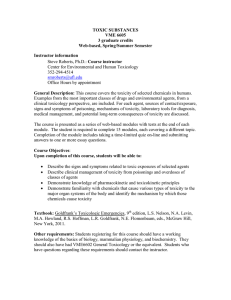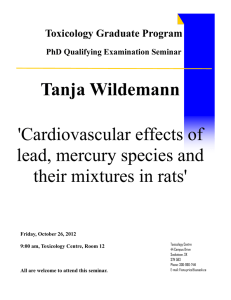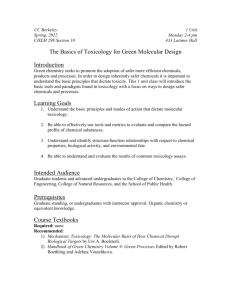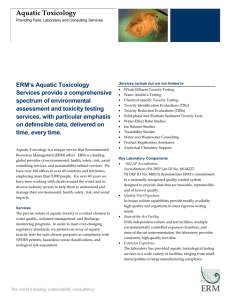Alternative toxicity test methods: reducing, refining and replacing
advertisement
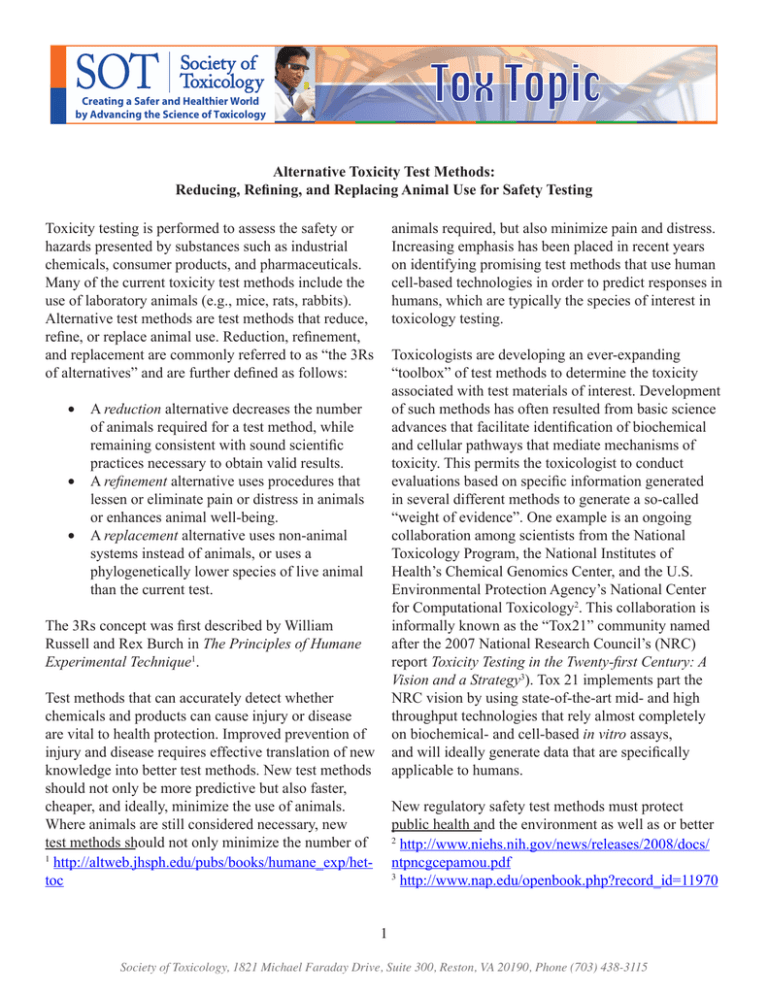
Creating a Safer and Healthier World by Advancing the Science of Toxicology Alternative Toxicity Test Methods: Reducing, Refining, and Replacing Animal Use for Safety Testing Toxicity testing is performed to assess the safety or hazards presented by substances such as industrial chemicals, consumer products, and pharmaceuticals. Many of the current toxicity test methods include the use of laboratory animals (e.g., mice, rats, rabbits). Alternative test methods are test methods that reduce, refine, or replace animal use. Reduction, refinement, and replacement are commonly referred to as “the 3Rs of alternatives” and are further defined as follows: animals required, but also minimize pain and distress. Increasing emphasis has been placed in recent years on identifying promising test methods that use human cell-based technologies in order to predict responses in humans, which are typically the species of interest in toxicology testing. Toxicologists are developing an ever-expanding “toolbox” of test methods to determine the toxicity associated with test materials of interest. Development of such methods has often resulted from basic science advances that facilitate identification of biochemical and cellular pathways that mediate mechanisms of toxicity. This permits the toxicologist to conduct evaluations based on specific information generated in several different methods to generate a so-called “weight of evidence”. One example is an ongoing collaboration among scientists from the National Toxicology Program, the National Institutes of Health’s Chemical Genomics Center, and the U.S. Environmental Protection Agency’s National Center for Computational Toxicology2. This collaboration is informally known as the “Tox21” community named after the 2007 National Research Council’s (NRC) report Toxicity Testing in the Twenty-first Century: A Vision and a Strategy3). Tox 21 implements part the NRC vision by using state-of-the-art mid- and high throughput technologies that rely almost completely on biochemical- and cell-based in vitro assays, and will ideally generate data that are specifically applicable to humans. • A reduction alternative decreases the number of animals required for a test method, while remaining consistent with sound scientific practices necessary to obtain valid results. • A refinement alternative uses procedures that lessen or eliminate pain or distress in animals or enhances animal well-being. • A replacement alternative uses non-animal systems instead of animals, or uses a phylogenetically lower species of live animal than the current test. The 3Rs concept was first described by William Russell and Rex Burch in The Principles of Humane Experimental Technique1. Test methods that can accurately detect whether chemicals and products can cause injury or disease are vital to health protection. Improved prevention of injury and disease requires effective translation of new knowledge into better test methods. New test methods should not only be more predictive but also faster, cheaper, and ideally, minimize the use of animals. Where animals are still considered necessary, new test methods should not only minimize the number of 1 http://altweb.jhsph.edu/pubs/books/humane_exp/hettoc New regulatory safety test methods must protect public health and the environment as well as or better 2 http://www.niehs.nih.gov/news/releases/2008/docs/ ntpncgcepamou.pdf 3 http://www.nap.edu/openbook.php?record_id=11970 1 Society of Toxicology, 1821 Michael Faraday Drive, Suite 300, Reston, VA 20190, Phone (703) 438-3115 than currently accepted methods. For this reason, test method validation must demonstrate that an alternative test method is scientifically valid and as protective as currently accepted methods. Adequate validation is demonstrated by an assessment of test method reliability and relevance. Reliability is the degree to which a new test method produces the same results when repeated by different laboratories at different times. Relevance is the extent to which the new test method correctly predicts or measures the relevant biological effect in humans or other species. A lack of consistent coordination and different processes used by validation organizations in the U.S., Europe, Japan, and elsewhere have contributed to differences in recommendations on the usefulness of alternative methods for regulatory purposes. However, an international cooperation on alternative test methods has now been established by recognized national validation organizations to promote enhanced coordination on the scientific validation of alternative test methods4. Such cooperation should increase the likelihood of developing internationally harmonized recommendations on alternative test methods that can be accepted worldwide. 4 http://www.fda.gov/InternationalPrograms/HarmonizationInitiatives/ucm114518.htm; http://jacvam.jp/ en_effort/en_icatm.html; http://iccvam.niehs.nih.gov/ about/icatm.htm 2 Society of Toxicology, 1821 Michael Faraday Drive, Suite 300, Reston, VA 20190, Phone (703) 438-3115

